Piła 2024-08-17
EZT Pesa Elf 2 EN96A-002, or 34WE, Factory No. E722BNA006. The 2-car train was manufactured by PESA in January 2018. In February 2018, three EZTs with numbers: EN96A-001, EN96A-002, EN96A-003; underwent tests in multiple traction on the Bydgoszcz Główna – Warlubie – Bydgoszcz Główna route. EZT EN96A-002 was received by PolRegio and assigned to the Kujawsko-Pomorskie Branch based in Bydgoszcz. From March 11, 2018, the train began carrying passengers.
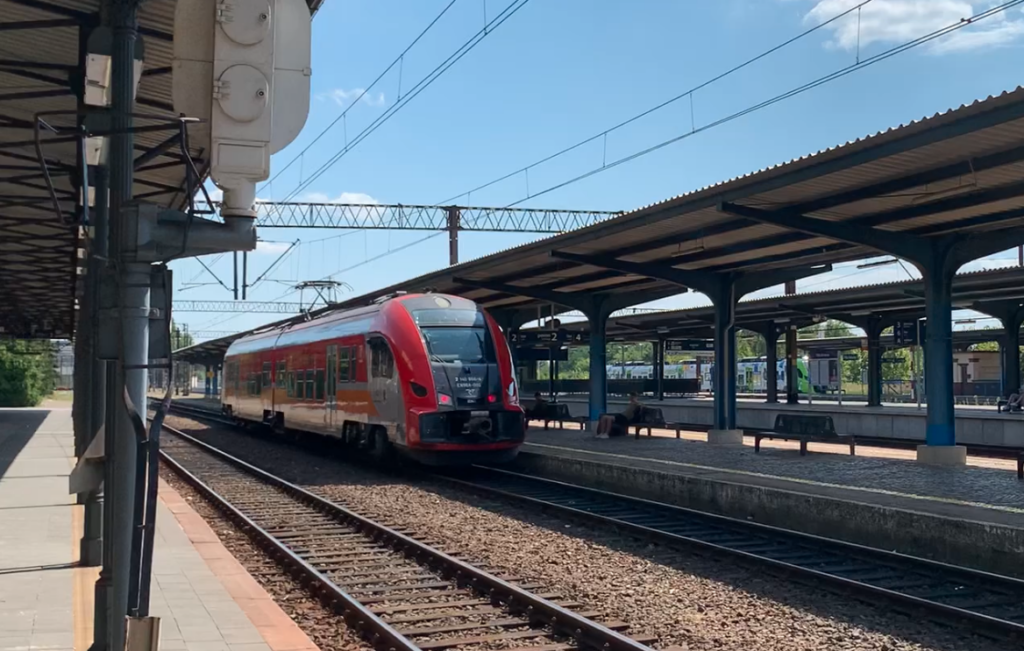
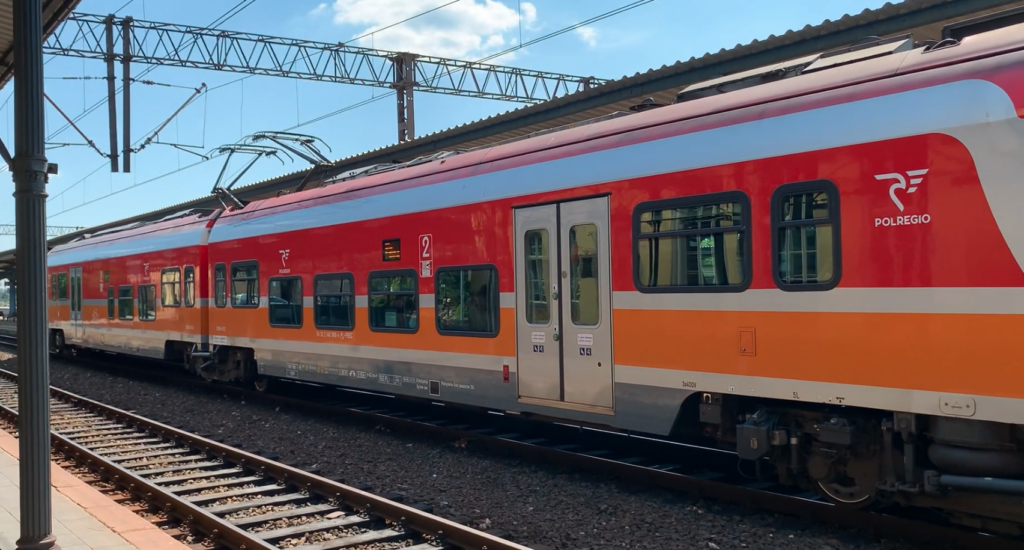
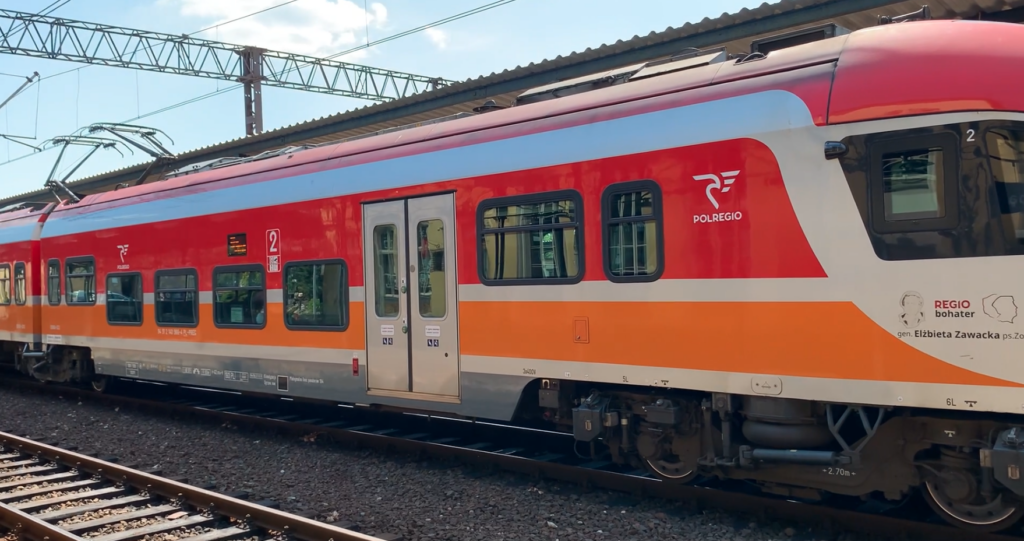
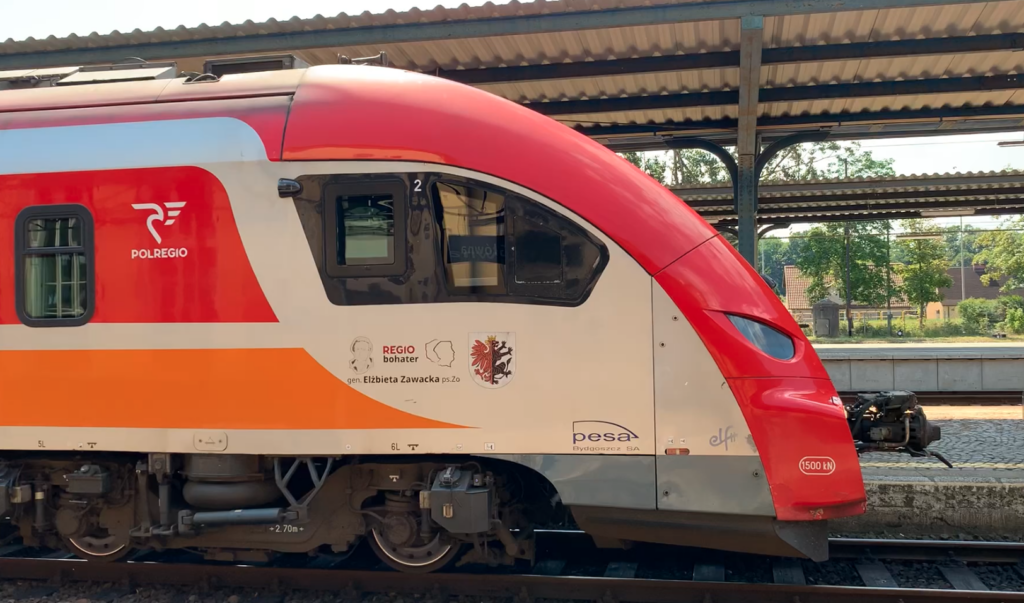
EZT Pesa Elf 2, EN96A-002 = 34WE.
Pesa Elf 2 trains are Polish Electric Multiple Units, adapted for regional traffic. The trains have been built since 2010, in the Polish Pesa factory in Bydgoszcz. “Elf” is an acronym for “electric low floor”, i.e. a low-floor electric vehicle. Pesa Elf 2 trains are manufactured with a different number of cars from two to six. The equipment, seat layout, number of toilets, etc. are also different.
The Elf train family includes the following models: Type EN62 = 21WE, Type EN76 = 22WE, Type EN96 = 34WE and 27WE for SKM Warsaw. In addition to them, ETZ trains marked Acatus II and Acatus Plus were built. Type EN77 = 32WE Acatus II – 4-carriage. Type EN64 = 40WE Acatus Plus – 3-carriage. EN99 type = 41WE Actus Plus – 2-car. By 2020, over 120 Pesa Elf EZT trains have been produced.
Pesa Elf trains are powered by electric traction with a voltage of 3 kV DC. The width of the train is 2.88 m, the height is 4.28 m, the length depends on the number of cars. The design speed of Elf trains is 160 km/h. Although the first copy was adapted to a speed of 120 km/h.
The design of the EZT Pesa Elf 2 EN96A = 34WE.
The train consists of two cars. Each car is equipped with one pair of doors. This arrangement foreshadowed the operation of the train on routes with small passenger streams. All doors are located in the low-floor zone, under which there are retractable steps facilitating boarding from lower platforms, i.e. less than 0.55 – 0.76 m from the railhead. The first and last bogies are type 26MN driving bogies, with a wheelbase of 2.80 m. The middle bogie is a type 40AN rolling bogie in the Jacobs system, with a wheelbase of 3.00 m. Each of the bogies has double suspension. The first stage is made of steel springs. The second stage is made of pneumatic cushions. Hydraulic shock absorbers have been installed for additional vibration damping. The driving and rolling bogies are designed and manufactured by Pesa. Asynchronous motors MF 50-29-4 (400 KW) were used. The motors are of Austrian production. Asynchronous electric motors are controlled by a frequency converter. The train has two Stemmann current collectors, which are placed in the area of the wagon connection. Knorr-Bremse braking system.
Above all bogies there are zones of raised floor, which are accessed by stairs or ramps. Stairs in the form of three steps are located only in the area above the driving bogies. The diameter of the wheels is 0.85 m. The train has a system for lubricating the wheel flanges, only the first axle of the driving bogie. The train can run in multiple traction. It is possible to connect up to three trains in multiple traction. The trains are made as Class 2. In the passenger space there are one or two toilets in a closed system and a space for passengers with limited mobility, with large luggage or with a bicycle, near which, by the doors, there are lifts for the disabled. There is always a toilet for disabled people and people with small children, which has larger dimensions.
The wagon bodies have a spatial structure made of steel with closed profiles. The skin is 1.5 mm thick and made of steel, while the front of the vehicle is made of plastic.
Data T-T 34WE Elf 2.
ETZ 2-car. Axle arrangement Bo’2’Bo’. Power supply 3 kV DC. Four 400 kW motors. Acceleration 1 m/2. Design speed is 160 km/h. Track gauge 1,435 mm. Total length 42.83 m. Width 2.84 m. Height 4.30 m. Own weight 83,200 kg. Floor height 0.76 – 0.90 m. Entrance to the car is at a height of 0.76 m, from the railhead. Number of seats 107 + 6, depending on the user’s wishes. Structural strength category P – II according to EN 12663. Crash resistance C-1 according to EN 15227. The train has air conditioning, a closed toilet, space for bicycles and for prams and wheelchairs, WiFi, 230 V sockets, ticket machines.
EN96A-002, 34WE.
Four Pesa Elf 2 EN96A (34WE) trains for PolRegio (Przewozy Regionalne) were officially handed over on 23 March 2018. The ceremony took place at Toruń Główny station. The trains were directed, among others, to the following routes: Toruń – Bydgoszcz and Bydgoszcz – Inowrocław, Bydgoszcz – Smętowo, Bydgoszcz – Inowrocław, Piła – Toruń. The new trains joined the six already operating EZTs of the PESA company. The trains are equipped with 100 seats and space for transporting bicycles. The new vehicles are air-conditioned and have Wi-Fi Internet access. The vehicles are monitored online, both in terms of their technical condition and the safety of passengers.
Time for General Elżbieta Zawacka.
On March 29, 2019, the EN96A-002 train arrived at Bydgoszcz Główna station, which received its own name; General Elżbieta Zawacka, nicknamed “Zo”. General Elżbieta Zawacka is the patron of the military unit of the 8th Kujawska Territorial Defense Brigade.
Due to the 100th anniversary of Poland regaining independence, the company Przewozy Regionalne decided to commemorate people who were particularly distinguished in the fight for the freedom of our homeland. In each of the railway regions, a selected train gained a patron, with the designation REGIOhero. It was assumed that EZTs with the patron would run for over 2 years.
The REGIOhero campaign was covered by the National Patronage of the President of the Republic of Poland Andrzej Duda on the Centenary of Regaining Independence. The partner of the campaign was the Industrial Development Agency; the largest shareholder of Przewozy Regionalne and the “Niepodległa” Program.
Full list of regional train patrons:
Lower Silesia – Professor Julian Czyżewski.
2. Kuyavian-Pomeranian – General Elżbieta Zawacka, pseudonym “Zo”.
3. Lublin – General Franciszek Kleeberg.
4. Lubuskie – Captain Edmund Lesisz.
5. Łódzkie – Rotmistrz Aleksander Napiórkowski.
6. Lesser Poland – Lieutenant Colonel Ludwik Iwaszko.
7. Mazovia – sportsman Janusz Kusociński.
8. Opole – Lieutenant Colonel Bohdan Stanisław Sołtys.
9. Subcarpathia – Colonel Leopold Lis-Kula.
10. Podlaskie – Major Władysław Raginis.
11. Pomerania – Second Lieutenant Konrad Guderski, pseudonym “Konrad”.
12. Silesia – Polish and Silesian social and political activist Maria Kujawska.
13. Świętokrzyskie – Major Jan Piwnik, pseudonym “Ponury”.
14. Warmia-Masuria – Masurian poet and activist Michał Kajka, pseudonym “Prawdziński”.
15. Wielkopolskie – Brigadier General Roman Abraham.
16. West Pomerania – Polish People’s Army medic Ewelina Nowak.
Elżbieta Zawacka, pseudonyms “Zelma”, “Sulica”, “Zo”, was born on March 19, 1909, in Toruń, and died on January 10, 2009, also in Toruń. In September 1939, as a soldier of the Women’s Battalion of the Auxiliary Military Service, she took part in the defense of Lviv. She was a courier for the Home Army Headquarters, the only one out of 15 candidates to successfully complete difficult military training and serve in the ranks of the Cichociemni. She was a mathematician, professor of humanities, specializing in modern history. In 1996, as the second Polish woman in the history of the Polish Army, she was promoted to the rank of brigadier general. She was decorated, among others, with the Order of the White Eagle.
Written by Karol Placha Hetman
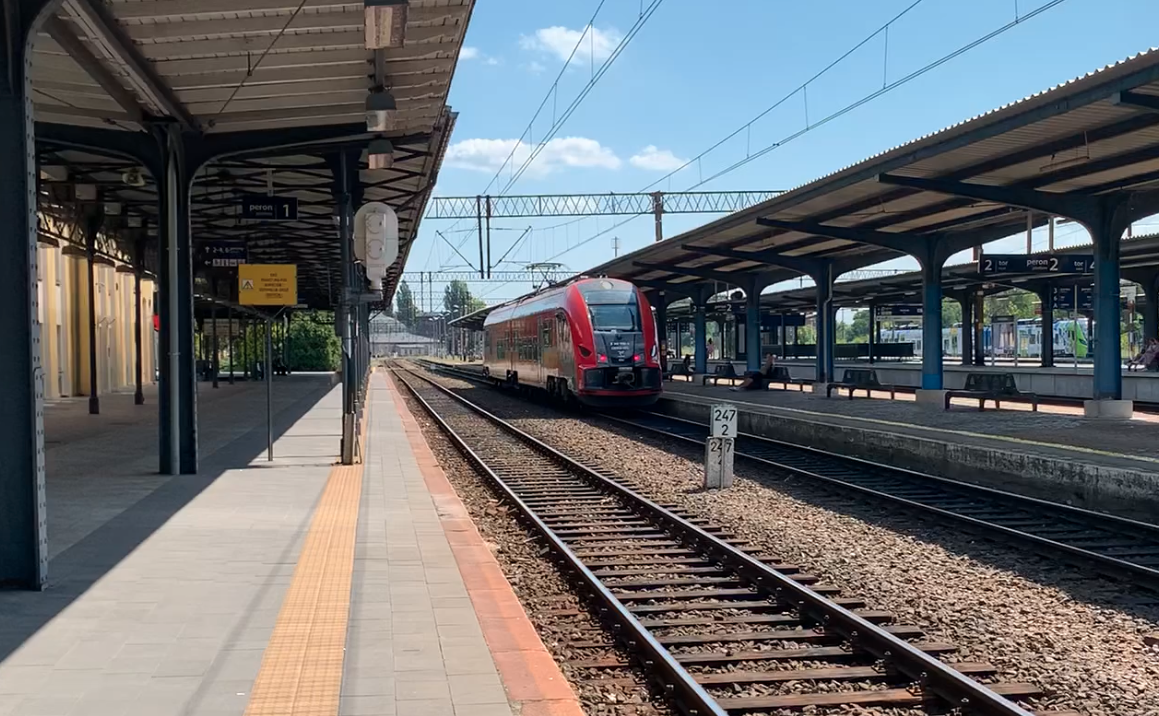
Leave a Reply
You must be logged in to post a comment.